Canadian economic accounts
Archived Content
Information identified as archived is provided for reference, research or recordkeeping purposes. It is not subject to the Government of Canada Web Standards and has not been altered or updated since it was archived. Please "contact us" to request a format other than those available.
Related subjects
-
[an error occurred while processing this directive]
Real gross domestic product (GDP) rose 0.4% in the fourth quarter, after advancing 1.0% in the third quarter. Consumer spending and exports contributed the most to fourth-quarter GDP growth. Final domestic demand grew 0.5%. On a monthly basis, real GDP by industry increased 0.4% in December.
Consumer spending on goods and services expanded 0.7% in the fourth quarter, up from the 0.4% gain in the previous quarter. Purchases of durable goods grew 2.1%, up from a 0.2% decline.
Business investment in plant and equipment advanced 2.0%, the eighth consecutive quarterly increase. Housing investment slowed to 0.8% in the fourth quarter, well below the 2.5% increase in the previous quarter.
Exports advanced 1.1% in the fourth quarter, down from a 3.8% gain in the third quarter. Imports rose 0.5%, after falling 0.4%.
Both goods-producing (+0.5%) and services (+0.4%) industries grew in the fourth quarter. Manufacturing, retail trade, and oil and gas extraction were the main contributors to the growth. Gains also occurred in professional, scientific and technical services, the public sector (education, health services and public administration combined) and construction. Mining excluding oil and gas extraction, utilities, wholesale trade, and the finance and insurance sector decreased during the quarter.
Note to readers
The historical revision to the Canadian National Accounts is scheduled for release beginning in October 2012. A schedule of releases has been posted on the English National economic accounts website. Additional information will be posted as it becomes available.
For more information, contact the information officer (csna-info-scnc@statcan.gc.ca).
Percentage changes for expenditure-based and industry-based statistics (such as personal expenditures, investment, exports, imports and output) are calculated from volume measures that are adjusted for price variations. Percentage changes for income-based and flow-of-funds statistics (such as labour income, corporate profits, mortgage borrowing and total funds raised) are calculated from nominal values; that is, they are not adjusted for price variations.
There are four ways of expressing growth rates for gross domestic product (GDP) and other time series found in this release.
1. Unless otherwise stated, the growth rates of all quarterly data in this article represent the percentage change in the series from one quarter to the next, such as from the third quarter to the fourth quarter of 2011.
2. Quarterly growth can be expressed at an annual rate by using a compound growth formula, similar to the way in which a monthly interest rate can be expressed at an annual rate. Expressing growth at an annual rate facilitates comparisons with official GDP statistics from the United States. Both the quarterly growth rate and the annualized quarterly growth rate should be interpreted as an indication of the latest trend in GDP.
3. The year-over-year growth rate is the percentage change in GDP from a given quarter in one year to the same quarter one year later, such as from the fourth quarter of 2010 to the fourth quarter of 2011.
4. The growth rates of all monthly data in this release represent the percentage change in the series from one month to the next, such as from November to December 2011.
Manufacturing increased 1.5%, mostly on higher production of transportation equipment and machinery. There were widespread gains in retail trade (+1.4%), while wholesale trade declined 0.6%. Oil and gas extraction rose 0.9% in the fourth quarter, largely on increased natural gas production, as oil extraction was limited by maintenance activities during the quarter. Construction edged up 0.2% as declines in non-residential building construction partially offset the strength in engineering and repair works. Mining excluding oil and gas extraction decreased 3.8%, mainly because of a decline in output at potash mines as a result of lower foreign demand for fertilizer. Utilities declined 1.6% as unseasonably warm weather contributed to lower demand for electricity.
Growth of real gross domestic product similar to that of final domestic demand
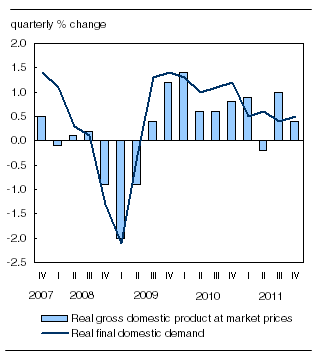
Chart description: Growth of real domestic product similar to that of final domestic demand
Expressed at an annualized rate, real GDP expanded 1.8% in the fourth quarter, following a 4.2% increase in the previous quarter. By comparison, real GDP in the United States grew 3.0% in the fourth quarter.
Contributions to percent change in real gross domestic product, fourth quarter 2011
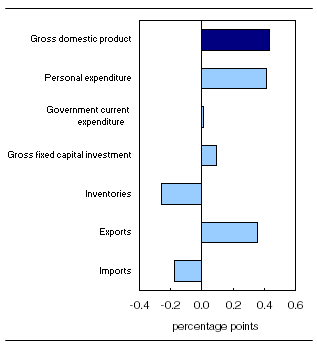
Consumer spending expands
Consumer spending on goods and services expanded 0.7% in the fourth quarter, led by purchases of durable goods (+2.1%). Purchases of semi-durable goods and services also rose. Purchases of non-durable goods were unchanged.
Personal spending on goods and services expands
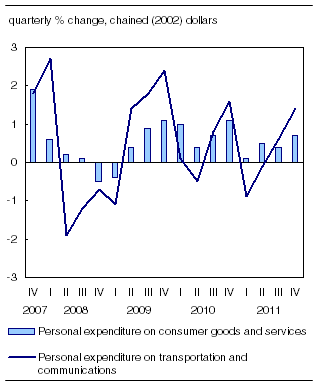
Chart description: Personal spending on goods and services expands
Spending on transportation and communication was up 1.4% in the fourth quarter. Purchases of new and used motor vehicles grew 3.4%, and outlays on motor vehicle repairs and parts were also up. Purchased transportation, which rose 1.2% in the quarter, has been increasing since the second quarter of 2009.
Spending on furniture, furnishings and household equipment advanced 0.7%, the strongest quarterly growth in 2011.
Clothing and footwear purchases increased 1.1% in the fourth quarter, the sixth consecutive quarterly increase.
Spending on recreation, entertainment, education and cultural services rose 1.3%, more than double the previous quarter's pace.
On the other hand, consumption of electricity, natural gas and other fuels declined, mostly because of unusually warm weather.
Housing demand slows
Housing investment grew 0.8% in the fourth quarter, about one-third of the pace of the previous quarter (+2.5%). New housing construction declined 0.4% following two quarters of increases of 3.0% or more.
Renovation activity slowed to 0.3% in the fourth quarter, following a 1.2% rise in the third quarter. In contrast, ownership transfer costs related to housing resale activity were up 4.9%, more than twice the pace of the previous quarter.
Business investment in plant and equipment rose
Overall business investment in plant and equipment rose 2.0% in the fourth quarter, the eighth consecutive quarterly gain.
Business investment in engineering structures led the increase, rising 4.2%, following a 6.1% gain in the third quarter. Investment in buildings edged up after two consecutive quarterly declines.
Business investment in machinery and equipment was up 0.7%. Increased investment in computers, telecommunications equipment, and industrial machinery was partly offset by declines in automobiles, other transportation equipment and software.
Business inventories increase
An increase of $7 billion in business inventories occurred in the fourth quarter. Both manufacturers and wholesalers increased their inventories. Retailers reduced their inventories, especially for motor vehicles.
Demand for exports slows after strong third quarter increase
Exports advanced 1.1% in the fourth quarter, down from 3.8% in the third quarter. Exports of goods increased 1.8%, while exports of services fell 2.7%.
The main contributors to the growth in goods exports were automotive products, energy products and industrial goods and materials. Exports of services fell 2.7%, led by declines in transportation, commercial and travel services.
Imports rose 0.5% in the fourth quarter, after declining 0.4% in the third quarter. Most major categories of goods imports increased, except for automotive products and other consumer goods. Imports of services edged down, their third quarterly decline in 2011.
Economy-wide income expands
Nominal GDP increased 1.5% in the fourth quarter. Corporate profits grew 5.0% following the 4.3% gain in the third quarter. Labour income was up 1.1%.
The personal saving rate was 3.4%, the same as the previous quarter's rate. The national saving rate was 7.0% in the quarter, largely because of the increase in corporate profits.
Purchasing power increases
Canada's real gross domestic income, a measure of purchasing power, increased 0.9% in the fourth quarter. Canada's terms of trade, which measures export prices relative to import prices, increased 1.5%.
The price of goods and services produced in Canada rose 1.1%. Export prices rose 3.5%, while import prices increased 2.0%.
The price of final domestic demand rose 0.7%, similar to the increase in the previous quarter.
Financial flow accounts: Demand for funds decelerates
Total funds raised by domestic non-financial sectors was $147 billion (seasonally adjusted at annual rates) in the fourth quarter, down from $228 billion in the third quarter. Financing activity was notably lower in the non-financial corporations and government sectors.
Non-financial private corporations financing activity slowed considerably in the fourth quarter to under one-third what it was in the third quarter. Most of this resulted from repayment of short-term paper and a lower level of share issues. Strong growth in undistributed earnings led to lower borrowing in the quarter.
Federal government borrowing also declined in the fourth quarter, led by redemptions of short-term paper. Borrowing by other levels of government fell by a similar amount, reflecting a significant reduction in bonds issuance by provincial governments.
Household borrowing (mortgages, consumer credit and loans) was also lower in the fourth quarter. In particular, mortgage borrowing by households was lower, reflecting a slowing in housing investment in the quarter. Overall household borrowing decelerated in the second half of 2011.
Financial institutions increased their bond holdings while decreasing their holdings of short-term paper. In comparison, loan lending activity was up in the quarter.
Non-residents continued to invest in Canadian securities, particularly through acquisitions of federal government bonds and short-term paper on the secondary market.
Annual, 2011
Real GDP grew 2.5% in 2011 after a 3.2% increase in 2010. Final domestic demand grew 3.0% after increasing 4.5% in 2010.
All major industrial sectors rose in 2011, except arts, entertainment and recreation. The production of goods grew 3.6% while services expanded 2.2%. Mining and oil and gas extraction, construction, the public sector (education, health services and public administration combined) and manufacturing were the main contributors to overall growth. Wholesale trade, retail trade, and the finance and insurance sector also posted gains. In addition, the transportation sector benefited from the general increase in economic activity.
Business investment in plant and equipment contributed the most to GDP growth in 2011. Businesses increased investments in non-residential structures by 13.7% in 2011, up from 2.8% in 2010. In addition, investment in machinery and equipment grew 13.7%. This was the second year in a row of machinery and equipment investment over 11%. The pace of housing investment slowed to 2.3% in 2011 from 10.2% in 2010.
Growth in Canadian exports and imports both slowed in 2011. Exports increased 4.4% following a gain of 6.4% in 2010. Exports of industrial goods and materials, energy products, and machinery and equipment all contributed to the 2011 increase. Imports advanced 6.5% after increasing 13.1%. Imports of machinery and equipment posted a second consecutive year of growth over 13%.
Consumer spending rose 2.2%, following 3.3% in 2010. Purchases of durable and semi-durable goods slowed considerably in 2011.
Government spending on goods and services grew 1.2%, half the 2010 pace of 2.4%. Capital spending declined 2.9% in 2011 in contrast to the 17.9% growth in 2010. Both government engineering and building construction declined in 2011.
The personal saving rate was 3.8% in 2011, down from 4.8%. Personal disposable income advanced 3.3%.
The national saving rate moved up to 6.5% in 2011 from 5.2% in 2010, as corporate saving increased 28%.
Real gross domestic income increased 3.8%, following a 5.0% gain. Canada's terms of trade rose 4.3%, following a 5.8% increase.
The price of goods and services produced in Canada increased 3.3% in 2011, a somewhat faster pace than in 2010 (+2.9%). The price of final domestic demand almost doubled (+2.0% in 2011 compared with +1.2% in 2010).
For the year as a whole, total funds raised in 2011 were down 10% to $217 billion from $242 billion in 2010. This decrease was primarily a result of an overall deceleration in borrowing in the non-financial private corporations and in the government sector. In the case of non-financial private corporations, the decrease in borrowing reflected strong earnings in 2011, giving rise to lower borrowing during the year.
Real gross domestic product by industry, December 2011
Real gross domestic product increased 0.4% in December after a 0.1% decline in November and no growth in October. About half of the December gain was accounted for by increased oil and gas extraction. Production also rose in manufacturing, wholesale trade, the finance and insurance sector and construction. Retail trade edged down, while the output of utilities declined.
Real gross domestic product increases in December
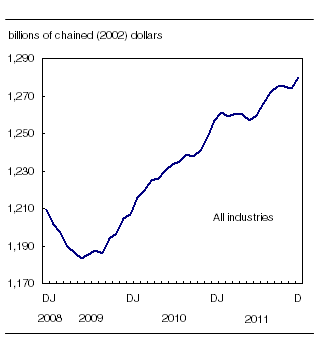
Chart description: Real gross domestic product increases in December
Oil and gas extraction rose in December (+3.0%), with increases in both crude petroleum and natural gas. This follows a 2.3% decline in November, which was partially due to maintenance activities. Support activities for mining, oil and gas extraction decreased 12% in December as drilling and rigging activities fell partly because of unfavourable weather. Mining excluding oil and gas extraction was up 1.1%.
Manufacturers increased their output (+0.9%) for a fourth consecutive month in December. The production of durable goods (+1.1%) led the way, particularly the manufacturing of motor vehicles and parts and of primary metals. Non-durable goods production (+0.5%) was also up, as increases were recorded in plastic and rubber products and printing.
Wholesale trade advanced 1.3% in December, on the strength of the wholesaling of food, beverage and tobacco products, and motor vehicles and parts. Retail trade edged down 0.1%, as increases in food and beverage stores and in furniture and home furnishings stores were offset by declines in general merchandise stores (which include department stores) and motor vehicle and parts dealers.
Construction rose 0.4% as both residential building construction and engineering and repair works increased in December. The output of real estate agents and brokers grew 2.6% as a result of higher home resale activity.
The output of the finance and insurance sector rose 0.5% in December, in part owing to increases in personal loans, business loans and residential mortgages issued by deposit-accepting institutions.
Utilities decreased 1.0% as the demand for both electricity and natural gas declined because of unusually warm weather in December.
Main industrial sectors' contribution to the percent change in gross domestic product, December 2011
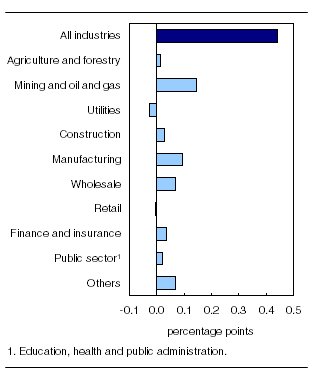
Products, services and contact information
Detailed analysis and tables
The National economic accounts module, accessible from the Key resource module of our website, features an up-to-date portrait of national and provincial economies and their structure.
Additional tables and links to other releases from the national accounts can be found in the fourth quarter 2011 issue of Canadian Economic Accounts Quarterly Review, Vol. 10, no. 4 (13-010-X, free). This publication is now available from the Key resource module of our website under Publications. It will be updated on March 15, at the time of the release of the National Balance Sheet Accounts. Revised estimates of the Income and Expenditure Accounts for the first, second and third quarters of 2011 have been released, along with those for the fourth quarter of 2011. These estimates incorporate new and revised source data and updated estimates of seasonal patterns.
Gross domestic product by industry
Available without charge in CANSIM: table 379-0027.
Definitions, data sources and methods: survey number 1301.
The December 2011 issue of Gross Domestic Product by Industry, Vol. 25, no. 12 (15-001-X, free), is now available from the Key resource module of our website under Publications.
Data on gross domestic product by industry for January 2012 will be released on March 30.
For more information, or to order data, contact the information officer (toll-free 1-800-887-4623; 613-951-4623; iad-info-dci@statcan.gc.ca). To enquire about the concepts, methods or data quality of this release, contact Allan Tomas (613-951-9277), Industry Accounts Division.
Income and expenditure accounts
Available without charge in CANSIM: tables 026-0009, 380-0001 to 380-0017, 380-0019 to 380-0035, 380-0056, 380-0059 to 380-0062 and 382-0006.
Definitions, data sources and methods: survey numbers, including related surveys, 1901 and 2602.
The fourth quarter 2011 issues of National Income and Expenditure Accounts: Data Tables, Vol. 4, no. 4 (13-019-X, free), and Estimates of Labour Income: Data Tables, Vol. 4, no. 4 (13-021-X, free), are also now available from the Key resource module of our website under Publications.
For more information, or to enquire about the concepts, methods or data quality of this release, consult the Guide to the Income and Expenditure Accounts (13-017-X, free) or contact the information officer (613-951-3640; iead-info-dcrd@statcan.gc.ca), Income and Expenditure Accounts Division.
Financial flow accounts
Available without charge in CANSIM: tables 378-0015 to 378-0048.
Definitions, data sources and methods: survey number 1804.
The fourth quarter 2011 issue of Financial Flow Accounts: Data Tables, Vol. 4, no. 4 (13-020-X, free), is also now available from the Key resource module of our website under Publications.
For more information, or to enquire about the concepts, methods or data quality of this release, contact the information officer (613-951-3640; iead-info-dcrd@statcan.gc.ca), Income and Expenditure Accounts Division.
- Date modified:
